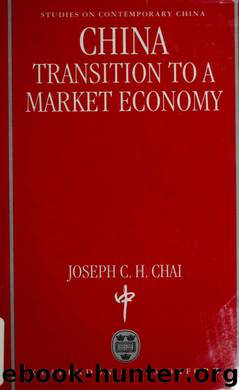China by C. H. Chai

Author:C. H. Chai
Language: eng
Format: epub
Tags: China -- Economic policy -- 1976-2000., China -- Economic conditions -- 1976-2000.
Publisher: Oxford University Press
Published: 1997-03-14T16:00:00+00:00
determination. However, it had serious repercussions for farm price incentives. To begin with, under the two-track system the contract price is a weighted average of the previous quota price and the above-quota price. This meant a significant drop in the average price received by farmers for their sales to the state. Second, the perversity in the state demand function facing the farmer was removed as the state no longer guaranteed to act as a buyer of last resort at the higher above-quota price but only at the lower quota price. In Figure 6.2 the state demand curve facing the farmer in the first stage of the reforms is the unbroken curve. Under the two-track system introduced in the second period of the reforms, if farmers had a 'bad' year so that they could only sell Q\ (where Q\ < Q and Q is the trend value of sales of the crop under normal weather conditions), the average and marginal revenue of farmers was equal to the contract price, Pc. If farmers had a good year and produced Q2, they would sell Q units at Pc and the remainder (Q2 - Q) to the market at the market price. The market price might be higher or lower than the contract price depending on market conditions. However, it would never fall below the old quota price as the government promised to act as a buyer of last resort at this price. Thus the new state demand curve and its associated marginal curve (the broken curves) were no longer sloping upward but downward. Third, since the floor price was now set at the lower quota price rather than the higher above-quota price the marginal purchase price received by farmers for their sales beyond the contracted amount to the state was also much lower. As can be seen from Figure 6.2, MR under the new system is significantly lower than that under the old one for output beyond Q.
Fourth, as the role of the market expanded farmers were also subject to the greater risk of price instability. The greater variability of purchase prices had its origin in two sources. First, there was more fluctuation of government fixed prices as the government switched from quantity to price planning (Lardy, 1983^). Fixed or contract prices were manipulated more frequently according to the demand and supply situation in order to guide farm production decisions (Sicular, 1988: 703). Second, there was also a greater fluctuation in market prices due to the lagged response of farmers to price incentives. The simple cobweb model shows that price and output fluctuate in a cyclical pattern because of this lagged response. The amplitude of the cycle will diminish over time as long as the elasticity of demand is larger than the elasticity of supply.
Download
This site does not store any files on its server. We only index and link to content provided by other sites. Please contact the content providers to delete copyright contents if any and email us, we'll remove relevant links or contents immediately.
International Integration of the Brazilian Economy by Elias C. Grivoyannis(87933)
The Radium Girls by Kate Moore(11896)
Turbulence by E. J. Noyes(7918)
Nudge - Improving Decisions about Health, Wealth, and Happiness by Thaler Sunstein(7529)
The Black Swan by Nassim Nicholas Taleb(6983)
Rich Dad Poor Dad by Robert T. Kiyosaki(6352)
Pioneering Portfolio Management by David F. Swensen(6205)
Man-made Catastrophes and Risk Information Concealment by Dmitry Chernov & Didier Sornette(5897)
Zero to One by Peter Thiel(5657)
Secrecy World by Jake Bernstein(4615)
Millionaire: The Philanderer, Gambler, and Duelist Who Invented Modern Finance by Janet Gleeson(4348)
The Age of Surveillance Capitalism by Shoshana Zuboff(4182)
Skin in the Game by Nassim Nicholas Taleb(4141)
Bullshit Jobs by David Graeber(4055)
The Money Culture by Michael Lewis(4049)
Skin in the Game: Hidden Asymmetries in Daily Life by Nassim Nicholas Taleb(3902)
The Dhandho Investor by Mohnish Pabrai(3676)
The Wisdom of Finance by Mihir Desai(3625)
Blockchain Basics by Daniel Drescher(3469)
